Introduction
When most people think of Egypt, images of the Nile River, the Great Pyramids, and the bustling markets of Cairo immediately come to mind. Yet, hidden beyond these well-known attractions lies an even greater treasure — the Egyptian Desert, which covers nearly 90% of the country’s land area.
Far from being lifeless, the deserts of Egypt are vibrant landscapes that hold fascinating histories, extraordinary natural wonders, and unique cultural traditions. These vast stretches of sand and stone have not only shaped Egypt’s geography but also influenced its civilization for thousands of years. They acted as protective shields, trade routes, and spiritual retreats, while today they serve as extraordinary destinations for explorers and travelers alike.
From the surreal chalk formations of the White Desert to the spiritual peaks of Mount Sinai, and from thriving oases to star-filled skies, the Egyptian Desert presents a mix of adventure, culture, and serenity that few other places in the world can match. In this section, we’ll explore the landscapes, climate, and natural life that define this timeless region.
The Landscape of the Egyptian Desert
Geographic Spread of the Deserts in Egypt
Egypt is home to four major desert regions, each with its own distinct identity:
-
The Eastern Desert:
-
Stretching between the Nile River and the Red Sea, this area is rugged and mountainous. Its valleys, cliffs, and mineral-rich terrain made it a vital mining region in ancient times.
-
The Western Desert:
-
By far the largest, this desert covers about two-thirds of Egypt. Dotted with famous oases such as Siwa, Bahariya, and Dakhla, it offers a blend of golden dunes and lush greenery.
-
The Sinai Desert:
-
Situated on the triangular Sinai Peninsula, this desert holds deep spiritual and historical significance. It is home to Mount Sinai and St. Catherine’s Monastery, sacred to multiple faiths.
-
The Nubian Desert:
-
Found in southern Egypt near the Sudanese border, this section of the Sahara is one of the driest and least explored, making it a destination for serious adventurers.
Together, these regions create a diverse desert ecosystem that has shaped both Egypt’s past and its present identity.
Climate and Weather Conditions
The Egyptian Desert is known for its extreme yet fascinating climate:
-
Daytime Heat:
-
Summer temperatures often rise above 40°C (104°F), especially in July and August.
-
Cool Nights:
-
In sharp contrast, nights can be surprisingly chilly, particularly in winter, when temperatures sometimes drop close to freezing.
-
Minimal Rainfall:
-
Many areas receive less than 2 cm of rain annually. On rare occasions, sudden downpours can cause flash floods in desert valleys.
For travelers, the ideal time to visit is between October and April, when the heat is more manageable and conditions are pleasant for outdoor activities. Spring and autumn are especially good seasons for trekking, camping, and safaris.
Flora and Fauna of the Desert
Though at first glance the Egyptian Desert may seem barren, it is actually home to an impressive variety of plants and animals that have adapted to survive in extreme conditions.
Plant Life:
-
Acacia and tamarisk trees thrive in valleys and dry riverbeds.
-
Date palms are common in oases, providing food, shade, and economic support to local communities.
-
Herbal plants like wormwood and desert grasses are used in traditional remedies and for grazing animals.
Wildlife:
-
Fennec foxes, with their distinctive large ears, are well-suited to desert life.
-
Dorcas gazelles and sand cats are agile mammals that roam the dunes.
-
Reptiles, including lizards and snakes, survive by regulating their body temperature to cope with heat.
-
Birds, such as migratory species, stop at oases during their seasonal journeys, making the desert a hotspot for birdwatchers.
This balance of flora and fauna shows how resilient and resourceful life can be in one of the harshest environments on Earth.
Historical Significance
The Egyptian Desert is not just a vast stretch of sand; it has always been central to the country’s history and survival. For thousands of years, these arid landscapes shaped Egypt’s trade, defense, and cultural identity.
Ancient Trade Routes
Long before highways and modern transportation, the desert served as Egypt’s lifeline of trade and communication.
-
Caravan Highways:
-
The Eastern Desert connected the Nile Valley with the Red Sea. Caravans transported incense, spices, gold, and minerals to Arabia, India, and beyond.
-
Darb el-Arbain (The Forty Days Road):
-
This famous route cut across the Western Desert, linking Egypt with Sudan. Traders moved ivory, livestock, and precious goods along this path, which typically took forty days to cross.
-
Global Connections:
-
Egypt’s desert routes are tied into the greater Silk Road network, cementing its role as a hub of international trade and cultural exchange.
Through these paths, the desert became not a barrier, but a bridge between civilizations.
Desert as a Protective Barrier
The desert was more than a trade route; it was also Egypt’s natural defense system.
-
Natural Shield:
-
Vast, inhospitable sands discouraged invaders, acting as a protective wall around the Nile Valley.
-
Strategic Advantage:
-
This natural barrier allowed Egyptian rulers to focus their military defenses on more accessible borders, like the Mediterranean coast.
-
Hidden Sanctuaries:
-
Many tombs and temples were built deep within the desert, where their isolation kept them safe from looters and preserved them for centuries.
The desert’s role as both protector and sanctuary helped Egypt endure as a stable and powerful civilization.
Archaeological Sites in the Desert
The Egyptian Desert is a treasure chest of ancient ruins and artifacts, many still being uncovered by archaeologists today.
-
Temples of Kharga Oasis:
-
The Hibis Temple, dedicated to Amun and dating back to the Persian period, remains one of the best-preserved temples in the desert.
-
Golden Mummies of Bahariya:
-
Archaeologists unearthed hundreds of Greco-Roman mummies adorned with gold masks and jewelry, providing insight into ancient burial customs.
-
Prehistoric Rock Art:
-
In the remote Gilf Kebir Plateau, the Cave of Swimmers displays 10,000-year-old paintings of humans swimming, evidence that the Sahara was once fertile and filled with life.
These sites highlight the desert not as an empty wasteland, but as a living archive of history.
Main Tourist Attractions
Today, Egypt’s deserts are as much about modern exploration as they are about ancient history. With surreal landscapes and fascinating oases, they remain some of the country’s most unforgettable destinations.
White Desert National Park
The White Desert (Sahara el Beyda) is one of Egypt’s most unique landscapes.

-
Otherworldly Formations:
-
Wind and sandstorms have sculpted chalk and limestone into strange shapes resembling animals, mushrooms, and giant towers.
-
Camping Adventure:
-
Spending the night here is magical. Under moonlight, the glowing white formations create an atmosphere that feels like another world.
-
Access:
-
Most visitors enter the White Desert from Farafra Oasis, with tours led by experienced guides.
No other desert on Earth looks quite like this — it is a must-see for first-time travelers.
Black Desert
Just beyond the White Desert lies the striking Black Desert.
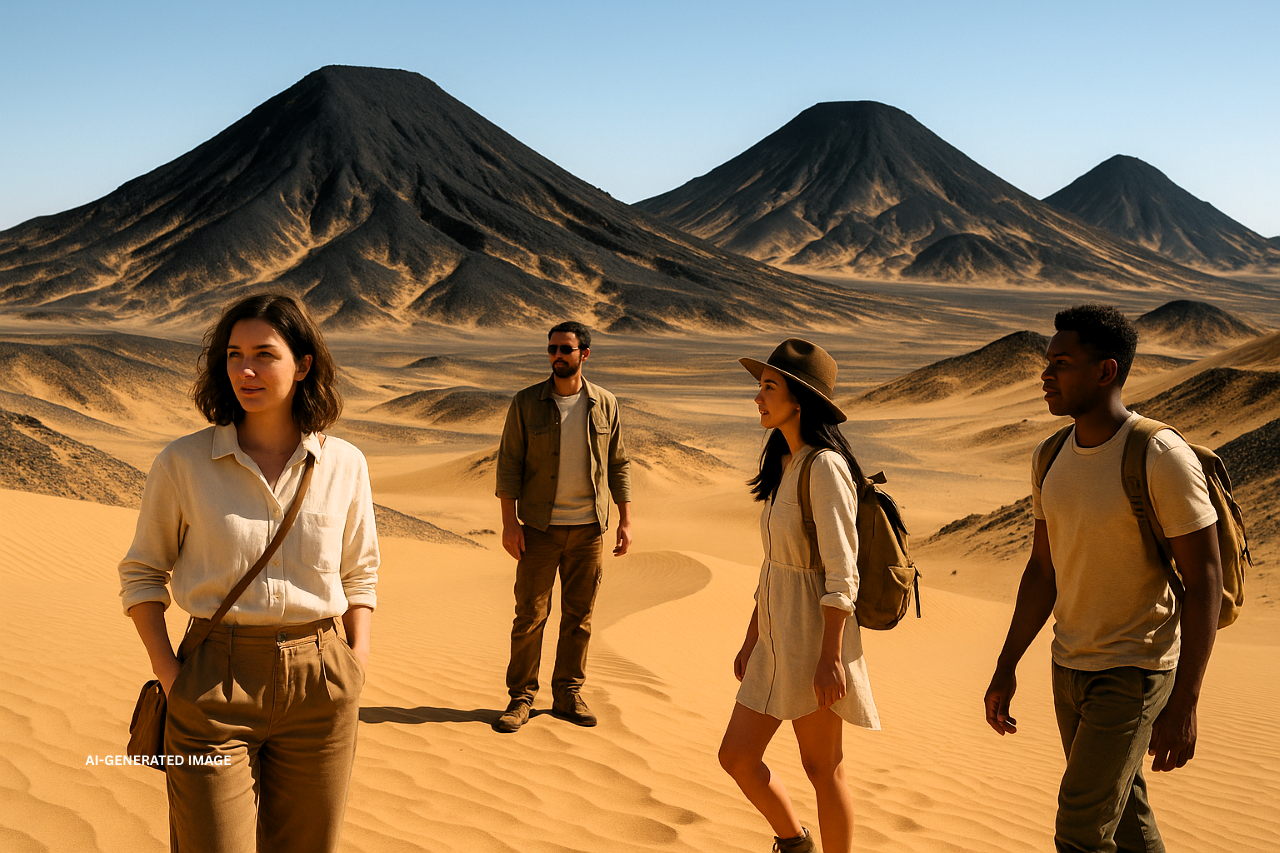
-
Volcanic Landscape:
-
Its dark hills, capped with basalt rock, tell the story of an ancient volcanic past.
-
Panoramic Views:
-
Climbing one of these hills rewards travelers with sweeping views of golden sands dotted with black peaks.
-
Photographic Paradise:
-
The dramatic contrast between black and gold makes it a favorite spot for photographers.
The Black Desert offers a raw and rugged beauty that complements the White Desert perfectly.
Siwa Oasis
Deep in the Western Desert near the Libyan border, Siwa Oasis is one of Egypt’s most enchanting destinations.
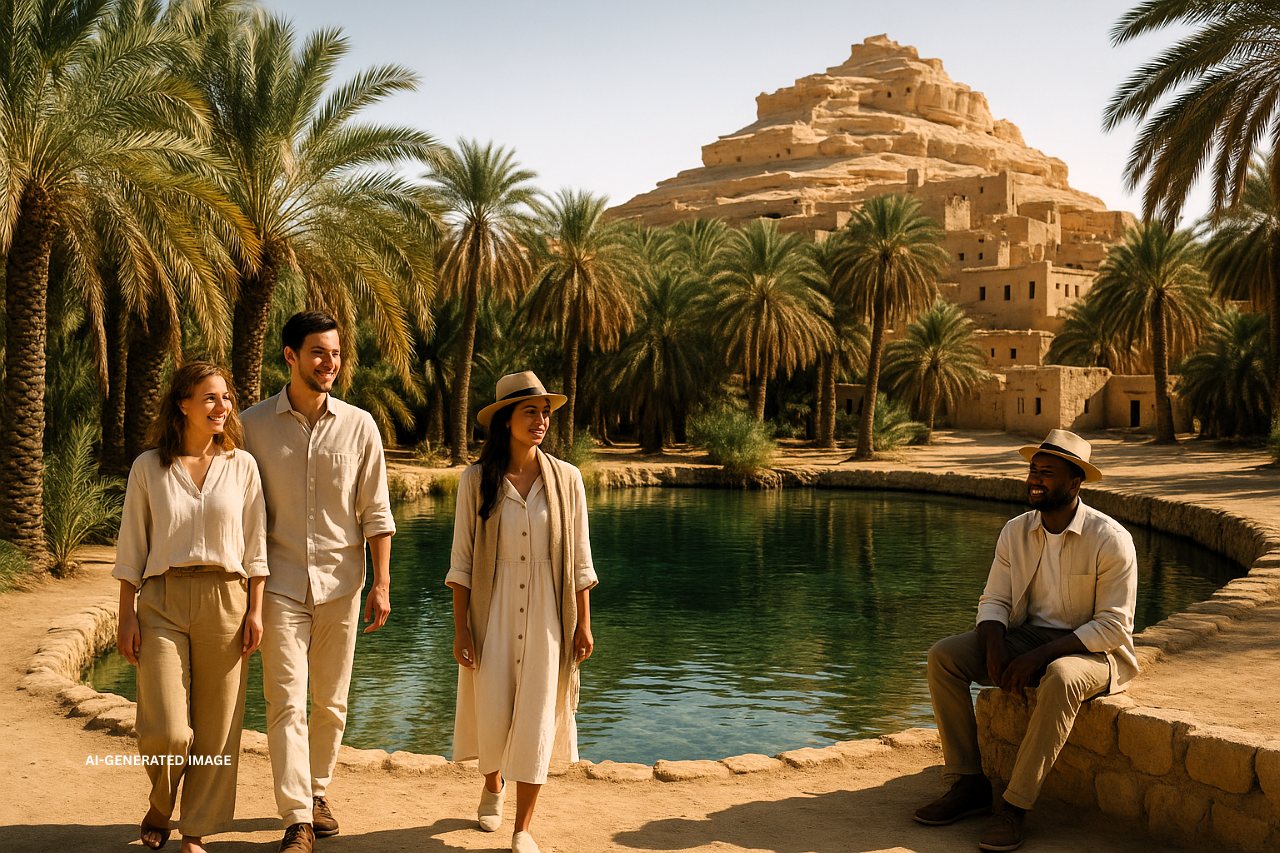
-
Natural Springs:
-
Siwa is famous for its freshwater pools and salt lakes. The most popular is Cleopatra’s Bath, a stone pool where visitors still enjoy refreshing swims.
-
Cultural Heritage:
-
The oasis is home to the Siwan Berbers, who preserve their own language, crafts, and customs.
-
Temple of the Oracle:
-
This ancient sanctuary became legendary when Alexander the Great visited in 331 BCE to consult the oracle about his divine status.
-
Eco-Friendly Stays:
-
Many accommodations in Siwa are built from mud-brick using traditional methods, blending sustainability with cultural authenticity.
Siwa Oasis is a rare place where nature, culture, and history come together, offering travelers a truly memorable experience.
Bahariya Oasis
Located about 365 km southwest of Cairo, Bahariya Oasis is a fertile retreat surrounded by golden sands. It is both a center of history and a gateway to nearby desert wonders.
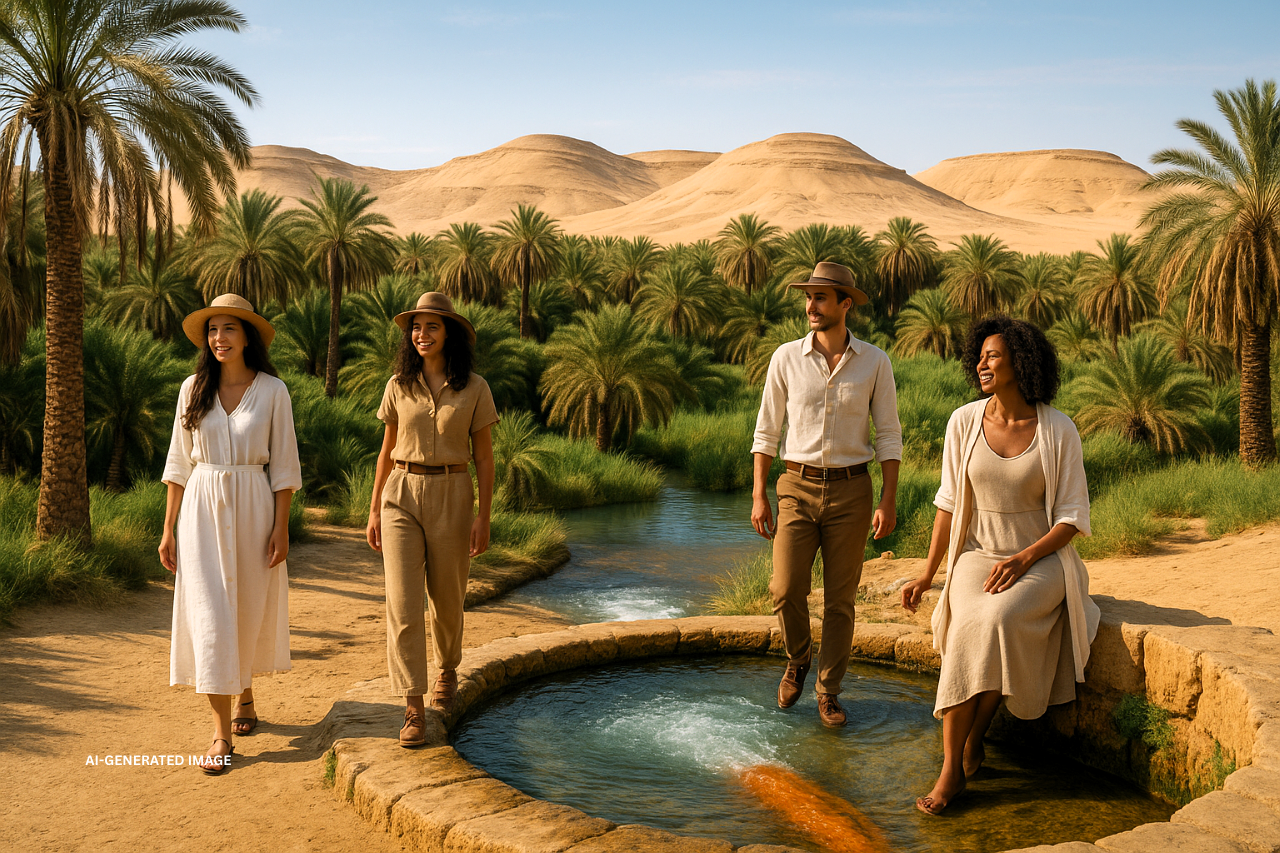
-
Valley of the Golden Mummies:
-
This extraordinary discovery revealed hundreds of Greco-Roman mummies, many adorned with golden masks and intricate decorations. It remains one of the largest and most fascinating archaeological finds in Egypt.
-
Palm Groves & Hot Springs:
-
Bahariya is rich with date palms, olive groves, and natural hot springs, offering visitors both relaxation and scenic beauty.
-
Starting Point for Safaris:
-
The oasis is the launchpad for expeditions into the White and Black Deserts, making it a hub for adventurers.
Bahariya combines archaeology, natural charm, and modern accessibility, making it an unmissable stop on a desert itinerary.
Farafra Oasis
Quieter than Bahariya, Farafra Oasis is a peaceful settlement where traditions remain strong.
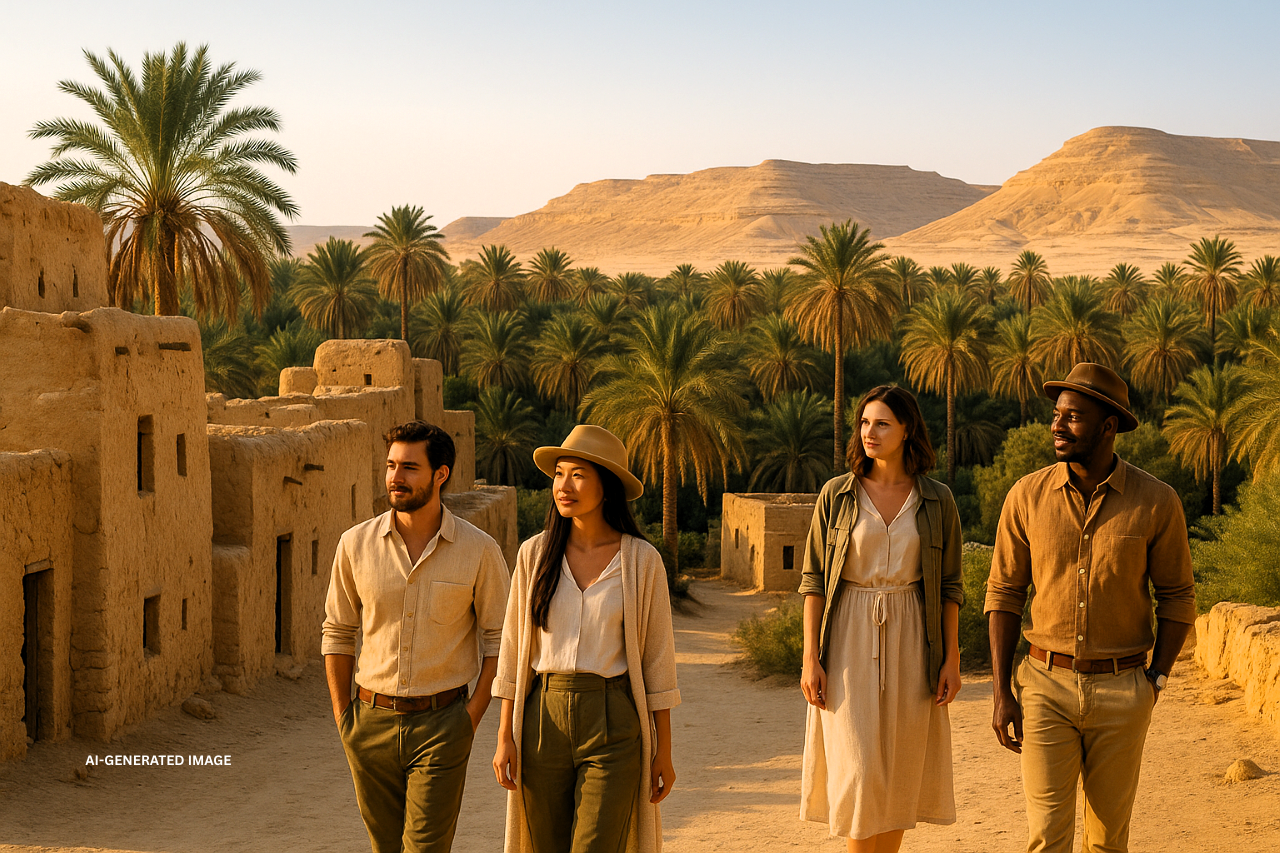
-
Local Culture:
-
Mud-brick villages here reflect simple desert living, with residents preserving age-old customs.
-
Gateway to the White Desert:
-
Farafra is the main access point to the White Desert, with many guided tours departing from its edge.
-
Artistic Heritage:
-
Pottery and handicrafts inspired by desert landscapes are still produced by local artisans.
Farafra is ideal for travelers seeking an authentic desert experience away from the crowds.
Kharga Oasis
The Kharga Oasis is the largest in the Western Desert, blending ancient ruins with modern life.
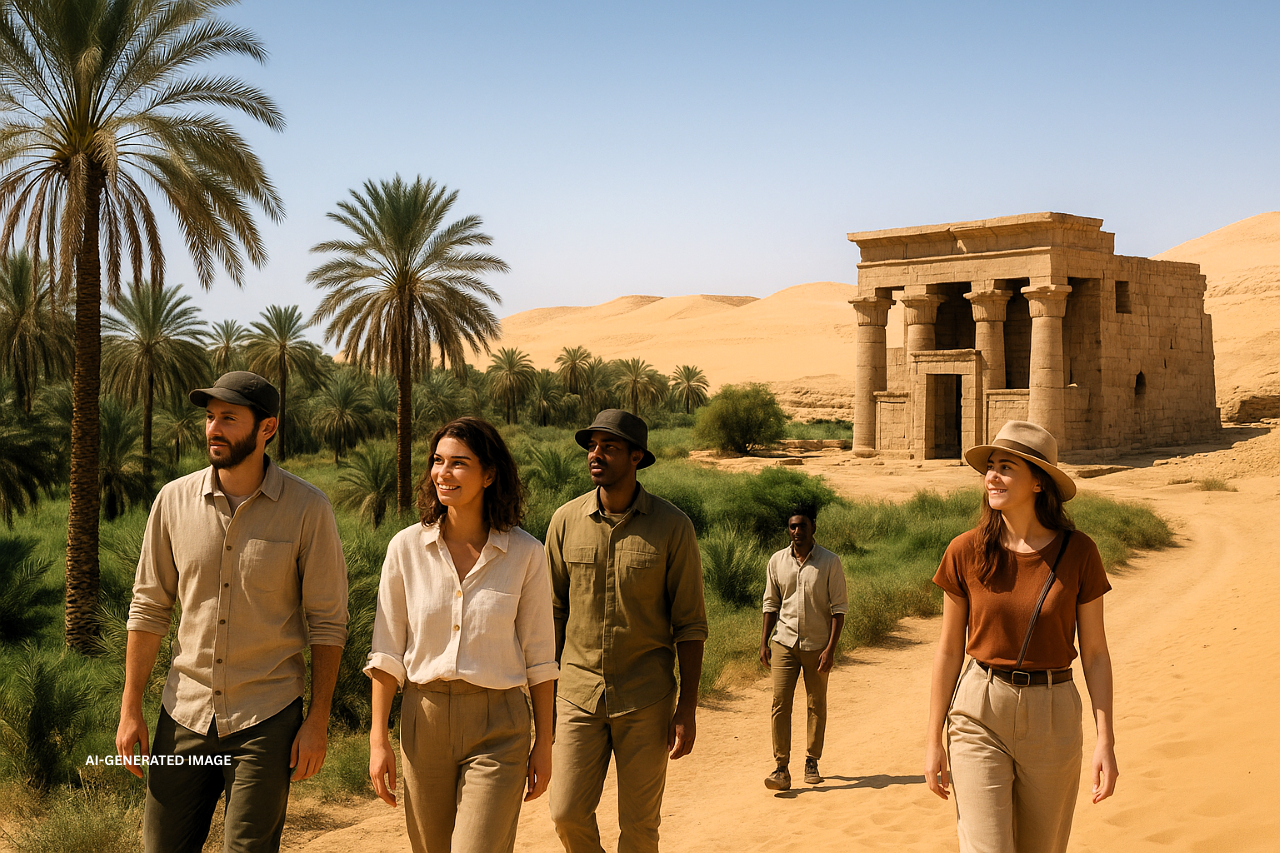
-
Hibis Temple:
-
Dating back to the 6th century BCE, this temple dedicated to Amun is one of the best-preserved monuments of the Persian era in Egypt.
-
Roman Influence:
-
Kharga is dotted with Roman forts, cemeteries, and settlements, showing its role as a critical trade and military hub.
-
A Modern Center:
-
Today, Kharga is a thriving town that mixes desert heritage with contemporary living.
Kharga offers a fascinating look at how the desert has been both a historical crossroads and a living community.
Dakhla Oasis
Dakhla Oasis is a blend of breathtaking landscapes and medieval heritage.
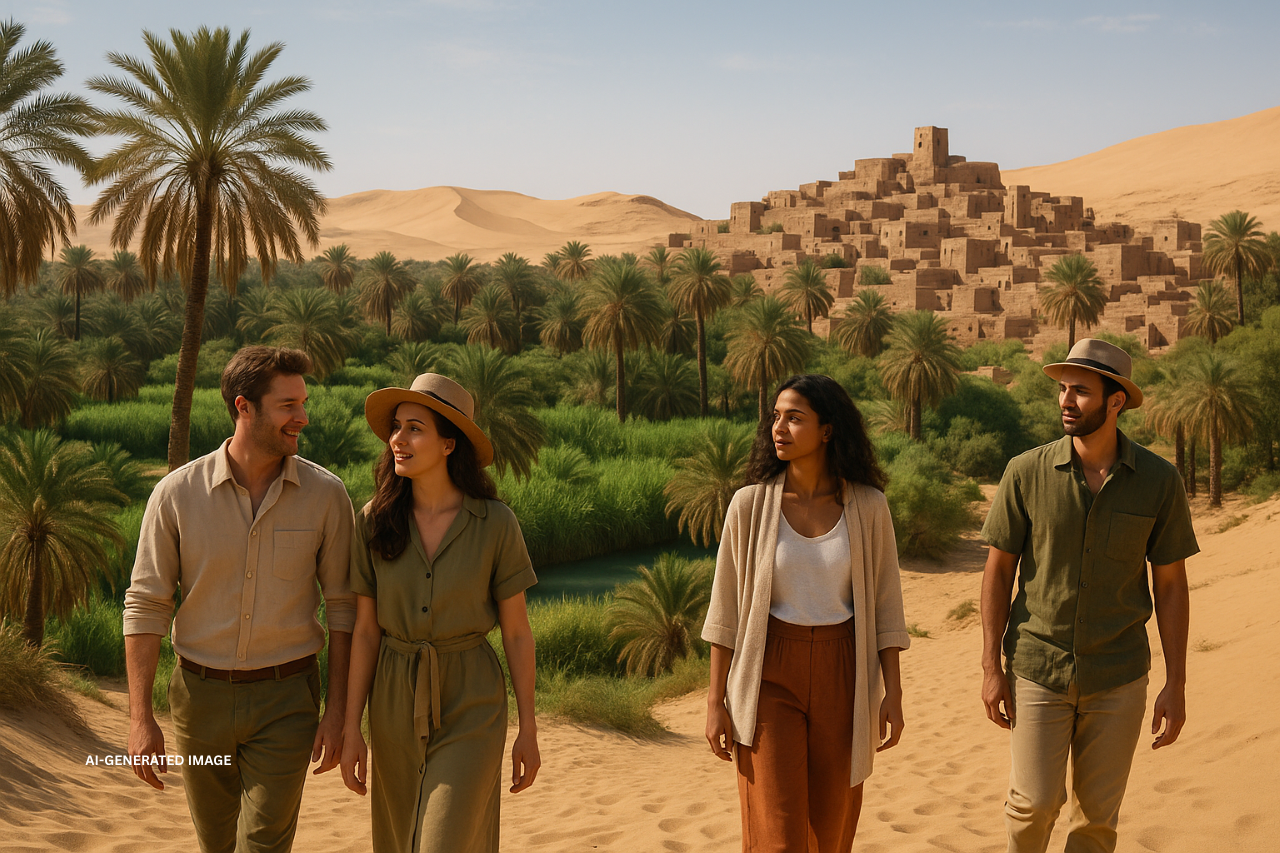
-
Al-Qasr Village:
-
This old Islamic town features narrow alleys, mud-brick houses, and historic mosques, transporting visitors back in time.
-
Natural Beauty:
-
Surrounded by cliffs and palm groves, the oasis offers striking desert scenery.
-
Crafts & Traditions:
-
Families here continue pottery and weaving traditions, keeping local craftsmanship alive.
Dakhla is an ideal destination for those who want to combine history, nature, and culture in one journey.
Sinai Desert Attractions
The Sinai Desert is renowned for its unique blend of religious heritage and natural beauty.
-
Mount Sinai:
-
Believed to be the place where Moses received the Ten Commandments, this sacred mountain is often climbed by pilgrims at dawn to witness breathtaking sunrises.
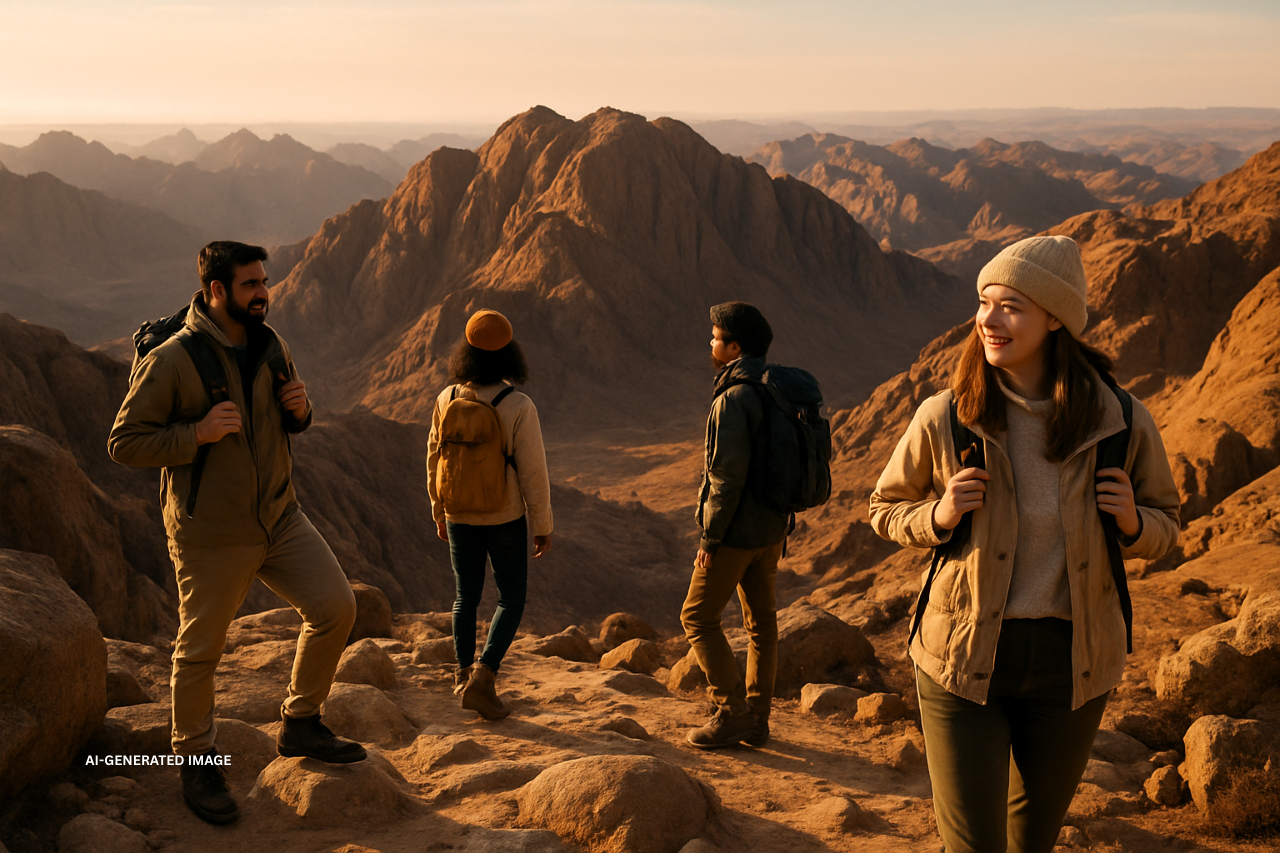
-
St. Catherine’s Monastery:
-
Situated at the mountain’s base, this UNESCO World Heritage Site is one of the world’s oldest functioning monasteries and houses priceless manuscripts and icons.
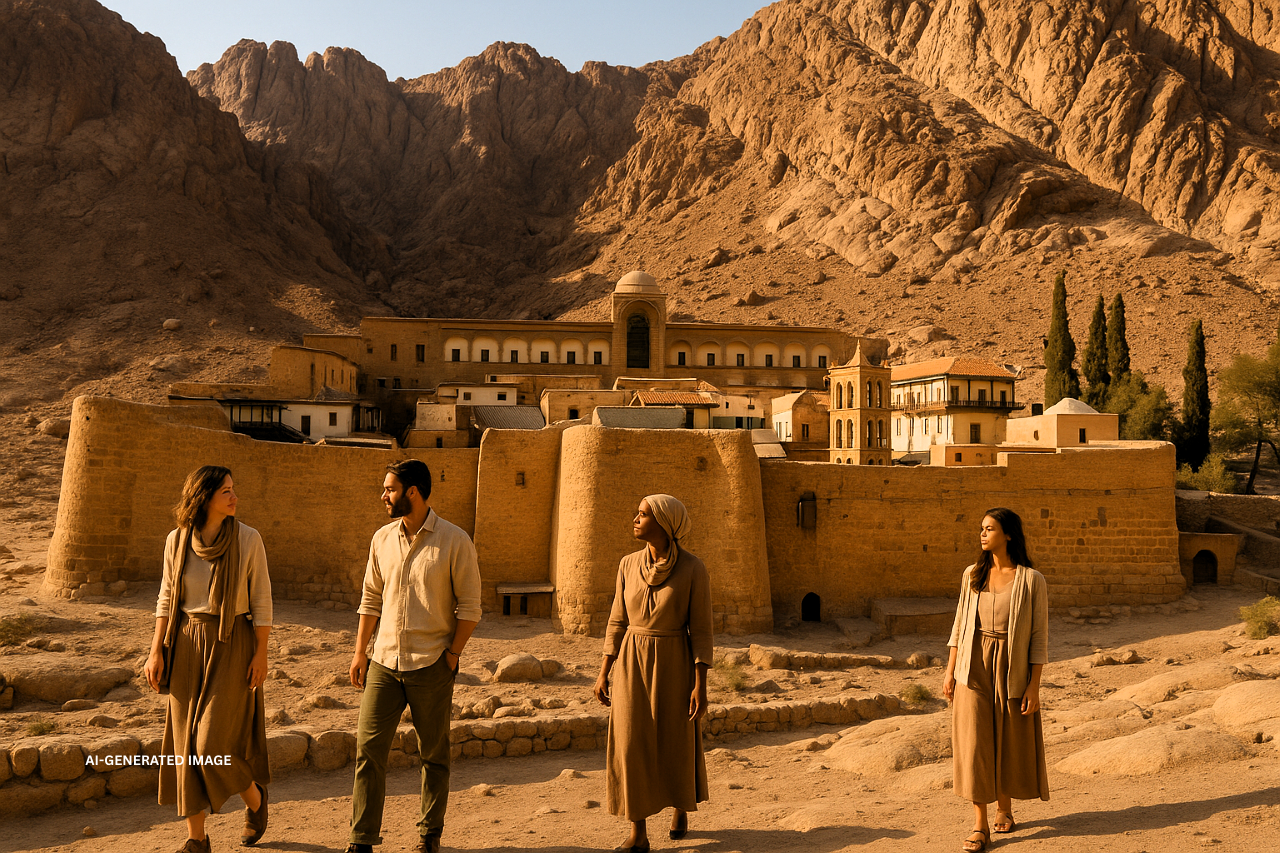
-
Bedouin Hospitality:
-
Local tribes welcome visitors with traditional meals, guided hikes, and storytelling, adding cultural depth to the experience.
The Sinai Desert is where faith, history, and culture meet in a dramatic landscape.
Gilf Kebir Plateau
Remote and rugged, the Gilf Kebir Plateau is one of Egypt’s most adventurous destinations.
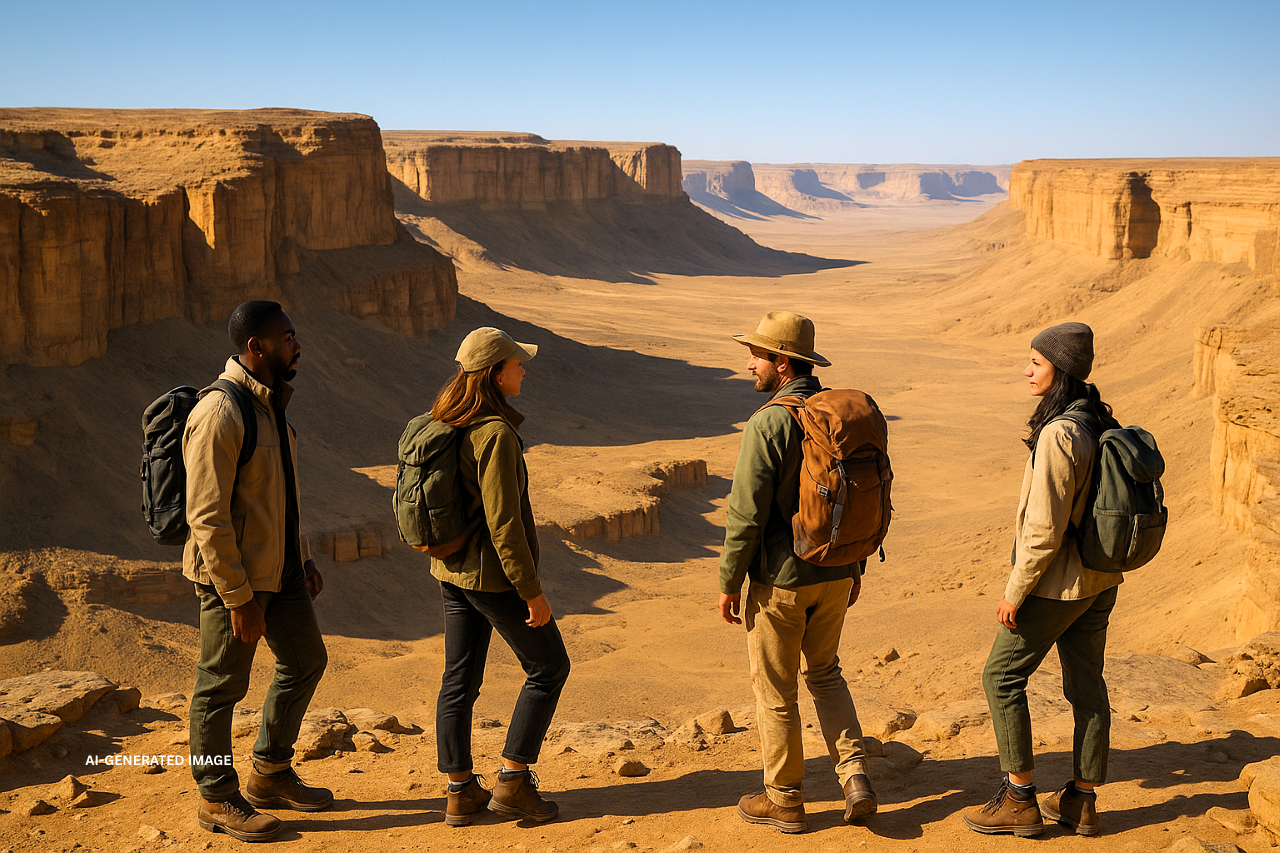
-
Prehistoric Rock Art:
-
The Cave of Swimmers, discovered in the 1930s, contains rock paintings of people swimming, evidence that the Sahara was once green and fertile.
-
Challenging Access:
-
Reaching Gilf Kebir requires multi-day expeditions with 4×4 vehicles, making it suitable only for seasoned travelers.
-
Untouched Wilderness:
-
The plateau’s vast cliffs and canyons remain pristine, offering explorers a sense of stepping back in time.
Gilf Kebir is a destination for those seeking extreme adventure and untouched natural beauty.
Adventure and Activities
The Egyptian Desert is not only about sightseeing — it is a playground for both adventure seekers and those who enjoy tranquil escapes.
Desert Safaris
-
Jeep Safaris:
-
Off-road rides across dunes provide both excitement and an efficient way to explore vast areas.
-
Camel Treks:
-
Slower but more traditional, camel rides follow ancient caravan trails.
-
Combination Tours:
-
Many trips blend jeeps and camels, offering travelers the best of both worlds.
Camping Under the Stars
Spending a night in the desert is an unforgettable experience.
-
Traditional Camps:
-
Local guides arrange Bedouin-style camps with meals and bonfires.
-
Stargazing:
-
With minimal light pollution, the desert sky reveals countless stars and the Milky Way in stunning clarity.
-
Cultural Nights:
-
Music, storytelling, and shared meals create warm memories under the open sky.
Sandboarding and Dune Adventures
The dunes are not just scenic — they’re also made for fun.
-
Sandboarding:
-
Sliding down massive dunes on a board is a thrilling sport.
-
Dune Climbing:
-
Adventurers hike up towering dunes for panoramic views.
-
4×4 Dune Bashing:
-
For adrenaline junkies, dune bashing in off-road vehicles delivers heart-pounding excitement.
Hiking and Trekking Trails
For travelers who prefer exploration at a slower pace, hiking reveals the desert’s hidden beauty.
-
Mount Sinai:
-
A 2–3 hour climb rewards hikers with incredible sunrise views.
-
Eastern Desert Paths:
-
Ancient inscriptions, mining sites, and unique wildlife are found along little-known trails.
-
Guided Treks:
-
Local guides ensure safety while enriching the journey with cultural and natural insights.
The People of the Desert
Although the Egyptian Desert appears vast and empty, it has always been home to resilient communities that thrive in this challenging environment. Among them, the Bedouins stand out as the desert’s most iconic people, known for their hospitality, traditions, and deep connection to the land.
Bedouin Tribes and Their Lifestyle
The Bedouins, whose name means “people of the desert,” have lived in Egypt’s arid regions for centuries.
-
Nomadic Roots:
-
Traditionally, Bedouins moved across the sands with their herds, relying on camels and goats for transportation, food, and trade.
-
Hospitality:
-
Guests are welcomed warmly, often with sweet tea brewed over open fires and fresh bread. Hosting visitors is considered a duty and a source of pride.
-
Adapted Living:
-
Their tents, woven from goat hair, provide shade by day and warmth by night. Loose-fitting robes and scarves protect them from both the scorching sun and sudden sandstorms.
-
Modern Balance:
-
Many Bedouins today still hold onto their cultural roots while working as safari guides, drivers, and tour operators, blending tradition with modern livelihoods.
Their lifestyle reflects resilience, community spirit, and harmony with the desert.
Handicrafts and Local Art
The creativity of desert communities shines through their handmade crafts, which often serve both practical and decorative purposes.
-
Jewelry:
-
Bedouin women produce bold silver ornaments decorated with turquoise and coral.
-
Weaving:
-
Colorful rugs, blankets, and camel bags are woven on traditional looms, inspired by the shapes and shades of the desert.
-
Pottery:
-
In oases like Farafra and Dakhla, potters craft clay vessels used for cooking, water storage, and decoration.
Purchasing these items not only provides authentic souvenirs but also supports local families and helps preserve ancient skills.
Music and Folklore of the Desert
Music and oral storytelling are vital to desert culture, especially in the evenings around campfires.
-
Traditional Instruments:
-
Instruments such as the rebab (a stringed instrument) and the tabla (a hand drum) produce haunting, rhythmic sounds.
-
Songs of the Desert:
-
Lyrics often tell tales of love, migration, and life in the sands, passing wisdom from one generation to the next.
-
Folklore:
-
Legends of heroes, spirits, and mystical powers of the desert are shared as part of community identity.
These traditions keep the desert’s cultural heartbeat alive, enriching the travel experience with storytelling and music under the stars.
Practical Travel Tips
The Egyptian Desert is stunning but demanding. Proper preparation ensures that travelers enjoy its beauty safely and comfortably.
How to Reach the Deserts
Access depends on the desert region you plan to explore:
-
Western Desert:
-
Bahariya Oasis, about a five-hour drive from Cairo, is the main base for tours into the White and Black Deserts.
-
Eastern Desert:
-
Best explored from Luxor, Hurghada, or Marsa Alam, often combined with Red Sea adventures.
-
Sinai Desert:
-
Reached from Cairo or Sharm El-Sheikh, with Mount Sinai and St. Catherine’s Monastery as key highlights.
-
Remote Areas:
-
Destinations like Gilf Kebir require permits, skilled guides, and organized expeditions.
Best Time to Visit
-
October to April:
-
The most favorable period, with mild daytime temperatures and cool evenings.
-
May to September:
-
Extremely hot, often exceeding 45°C (113°F), making this season unsuitable for most visitors.
Planning trips during cooler months allows for trekking, camping, and safaris without extreme discomfort.
Packing Essentials
Travelers should be well-prepared for the desert environment.
-
Clothing:
-
Breathable fabrics for daytime and warm layers for cold nights.
-
Footwear:
-
Sturdy hiking boots or closed shoes for dunes and rocky areas.
-
Sun Protection:
-
Sunscreen, wide-brimmed hats, sunglasses, and scarves are vital.
-
Hydration & Food:
-
Carry extra water and snacks, even when traveling with a tour.
-
Other Gear:
-
A flashlight, portable charger, and a basic first aid kit are essential for overnight trips.
Safety Considerations
The desert is awe-inspiring but unforgiving, so safety should never be overlooked.
-
Stay Hydrated:
-
Drink water regularly and avoid heavy activity in peak heat hours.
-
Never Travel Alone:
-
Always explore with a licensed guide; dunes and valleys can be disorienting.
-
Wildlife Caution:
-
Shake shoes and bedding to avoid encounters with scorpions or reptiles.
-
Permits & Regulations:
-
Some desert areas require official permits, typically handled by tour operators.
With the right preparation, travelers can focus on experiencing the majesty and adventure of the Egyptian Desert.
Cultural and Spiritual Dimensions of the Desert
The Egyptian Desert is more than a geographical expanse — it is also a cultural and spiritual landscape that has influenced religions, philosophies, and ways of life for thousands of years.
Desert in Ancient Egyptian Religion
For the ancient Egyptians, the desert was both a protector and a place of mystery.
-
Solar Symbolism:
-
The blazing desert sun was linked to Ra, the sun god, whose daily journey across the sky symbolized life, death, and renewal.
-
Chaos and Balance:
-
The desert was associated with Set, the god of chaos, standing in contrast to the fertile Nile Valley, which symbolized order and life.
-
Sacred Sites:
-
Many temples and tombs were deliberately built in remote desert valleys, where their isolation reinforced their spiritual significance and ensured preservation.
The desert was deeply embedded in the spiritual imagination of ancient Egypt.
Desert as a Place of Solitude and Reflection
The desert’s silence and vast horizons have long attracted those seeking peace and reflection.
-
Christian Hermits:
-
During the early centuries of Christianity, monks retreated into the deserts of Egypt, establishing the world’s first monastic communities.
-
Islamic Mystics:
-
Sufi traditions also looked to the desert as a place of inner journey and divine connection.
-
Modern Retreats:
-
Today, yoga retreats, meditation camps, and wellness programs use the desert’s natural stillness as a backdrop for personal renewal.
The desert remains a refuge for solitude, spirituality, and self-discovery.
Modern Pilgrimages and Spiritual Tourism
Deserts continue to hold spiritual significance in the modern world.
-
Mount Sinai:
-
Pilgrims climb the mountain at dawn, retracing the biblical path of Moses and experiencing breathtaking views at sunrise.
-
Siwa Oasis:
-
Once the home of the Oracle of Amun, Siwa still attracts visitors seeking energy, healing, and reflection.
-
Wellness Tourism:
-
Spiritual retreats that combine desert living with holistic practices have become increasingly popular.
The Egyptian Desert remains a living spiritual destination, bridging ancient faith with modern journeys.
Photography and Storytelling in the Desert
The Egyptian Desert is one of the most photogenic places in the world, captivating photographers, filmmakers, and storytellers with its dramatic contrasts and vast horizons.
Golden Hour in the Desert
Sunrise and sunset transform the desert into a magical setting.
-
Changing Colors:
-
Sands shift from golden to red and pink as the sun rises or sets.
-
Soft Lighting:
-
The golden hour creates ideal conditions for photography, with shadows and highlights enhancing landscapes and portraits alike.
For photographers, the golden hour is the perfect time to capture the desert at its most beautiful.
Capturing Landscapes and People
-
Landscapes:
-
Wide-angle shots emphasize sweeping dunes, while close-ups highlight unique rock formations.
-
Portraits:
-
Bedouins and local villagers add a human dimension to desert photography, though permission and cultural respect are essential.
-
Astrophotography:
-
With minimal light pollution, the desert sky reveals countless stars and the Milky Way, making night photography especially rewarding.
The desert provides endless opportunities for visual storytelling.
Documentaries and Films Featuring the Desert
The Egyptian Desert has long been a backdrop for films and documentaries.
-
Classic Films:
-
Movies like Lawrence of Arabia and The English Patient captured their grandeur.
-
Documentaries:
-
Wildlife and archaeology films continue to reveal the desert’s mysteries to global audiences.
Through cinema and media, the desert has become a symbol of both beauty and endurance.
Sustainable Tourism
With growing tourism, sustainability is vital to protect the desert’s fragile landscapes and cultural heritage.
Environmental Challenges
-
Desertification:
-
Expanding sands threaten oases and farmlands.
-
Climate Change:
-
Rising temperatures and unpredictable rainfall put stress on both people and ecosystems.
-
Tourism Pressure:
-
Overcrowding at sensitive sites can damage natural and cultural treasures.
Responsible Travel Practices
Travelers can minimize their impact by:
-
Carrying reusable bottles and avoiding single-use plastics.
-
Supporting local guides, artisans, and eco-lodges.
-
Respecting wildlife and leaving no trace behind.
Conscious travel ensures that the desert remains unspoiled.
Eco-Tourism Initiatives
Several initiatives are paving the way for sustainable tourism.
-
Eco-Lodges in Siwa:
-
Built with mud-brick and powered by renewable energy.
-
Protected Areas:
-
Sites like the White Desert National Park balance visitor access with conservation.
-
Community Tourism:
-
Local involvement ensures that traditions and livelihoods benefit from tourism.
These efforts show that it is possible to enjoy the desert while preserving it for future generations.
Conclusion
The Egyptian Desert is a place of contrasts — silent yet full of stories, harsh yet breathtaking, ancient yet alive with adventure. From the surreal formations of the White Desert to the sacred peaks of Sinai, and from Bedouin hospitality to archaeological wonders, it offers experiences that linger long after the journey ends.
Traveling through the desert is not just about landscapes. It is about connecting with history, culture, and the enduring spirit of the people who live there. When explored responsibly, the desert becomes more than a destination — it becomes a journey of wonder, reflection, and discovery.
FAQs
Which desert is best for first-time visitors?
The White Desert, with its surreal landscapes and accessibility from Cairo, is ideal for beginners.
Is it safe to explore the desert?
Yes, with a licensed guide or organized tour. Independent travel without preparation is not recommended.
Are desert safaris family-friendly?
Yes, many safaris are suitable for families. Camel rides and short tours are particularly enjoyable for children.
Which oases should I visit?
Siwa, Bahariya, Kharga, Dakhla, and Farafra are the most popular and culturally rich.
How much time is needed to explore the desert?
A short trip can be done in 2–3 days, but a full exploration covering multiple oases may take a week or more.
Can desert tours be combined with city visits?
Yes, itineraries often connect Cairo with Bahariya or Luxor with the Eastern Desert.
Do I need a guide for camping?
Guided camping is highly recommended for safety and navigation.
What kind of clothing should I bring?
Light, breathable clothing for daytime, warm layers for evenings, and protective gear such as hats and scarves.
Are there cultural etiquettes when meeting Bedouins?
Dress modestly, ask before taking photos, and accept tea or food when offered as a sign of respect.
What makes the White Desert unique?
Its chalk and limestone formations, sculpted by the wind into extraordinary shapes, make it one of the most otherworldly deserts in the world.
